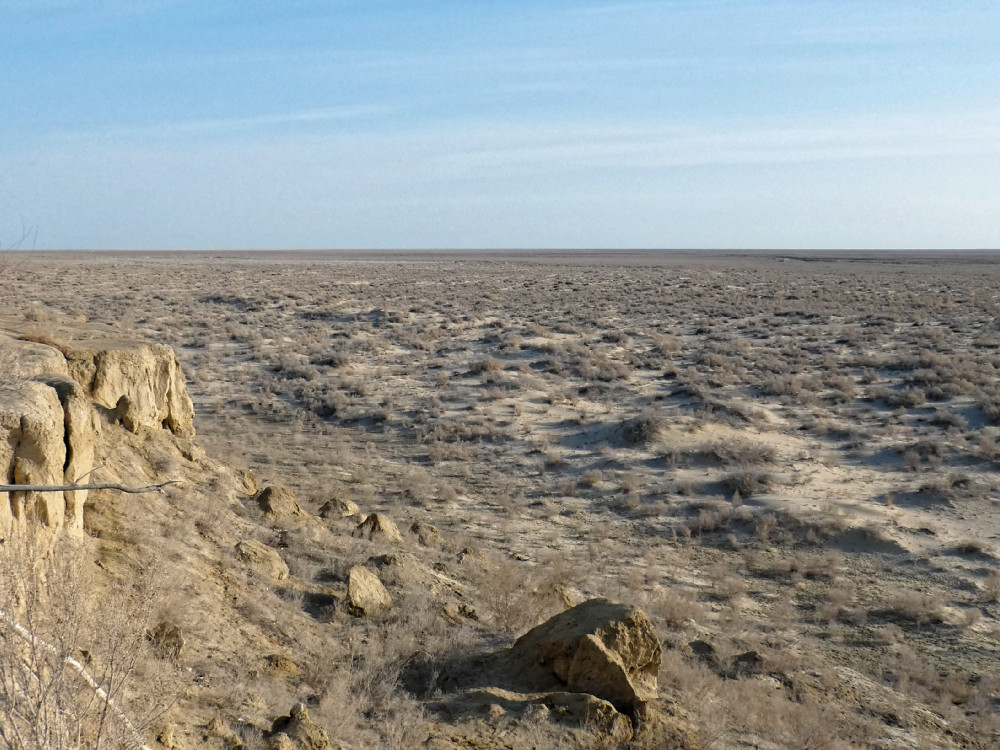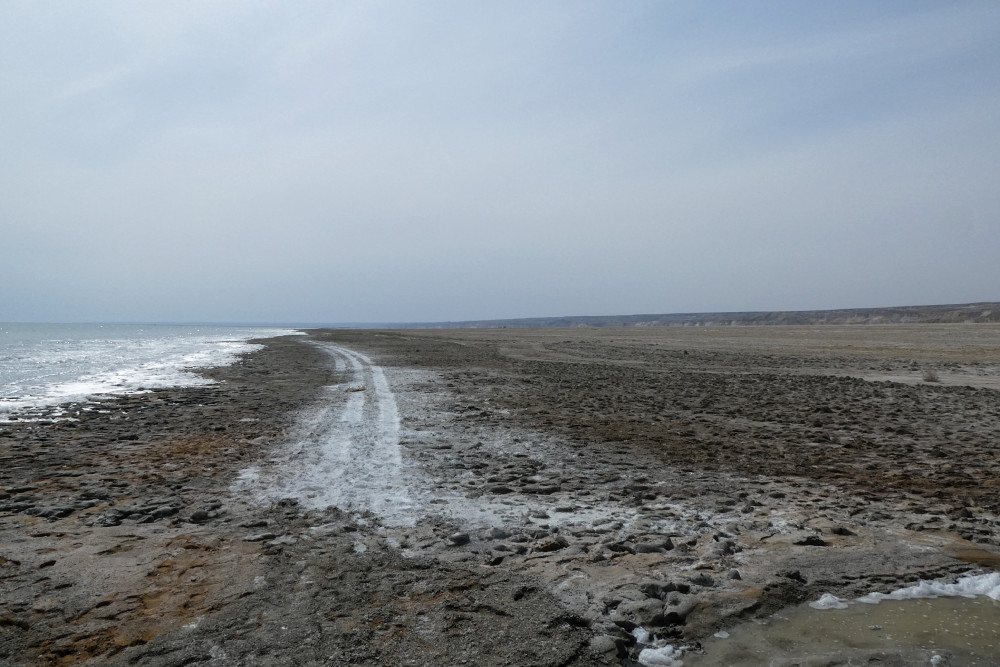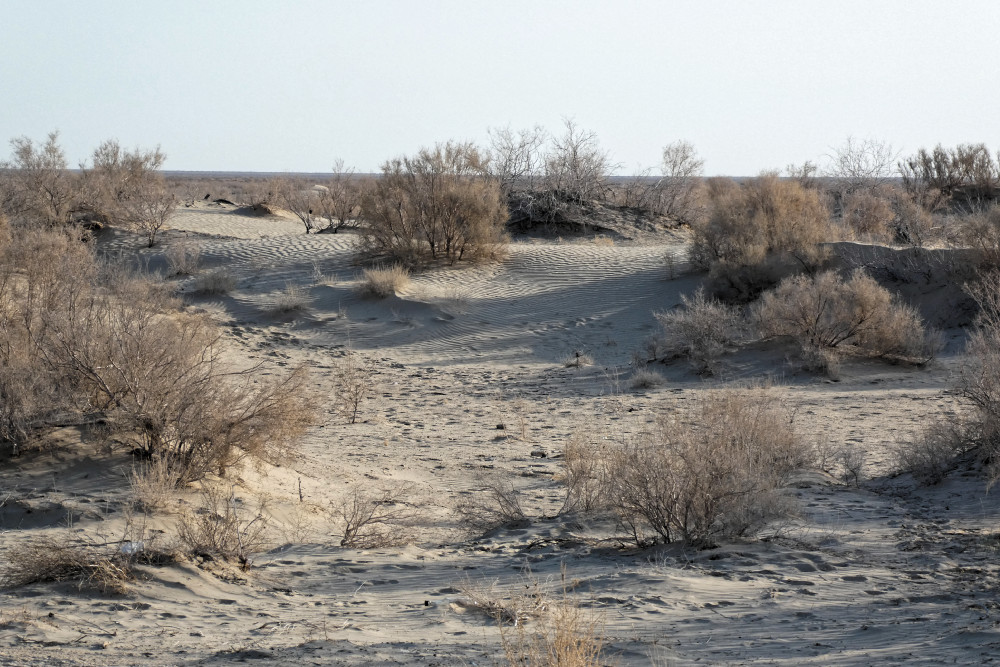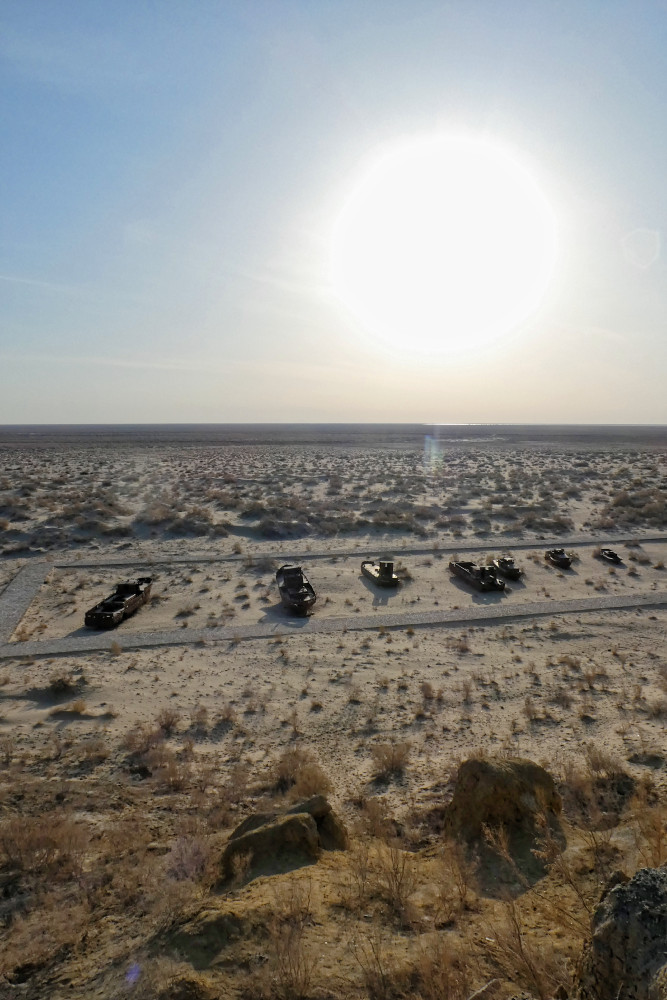Aral Sea has made Central Asia significantly dustier
Leipzig,
17.04.2024
Study by TROPOS and FU Berlin compares dust emissions in the 1980s and 2010s
Leipzig. The drying up of the Aral Sea has made Central Asia 7 percent dustier in the last 30 years. Between 1984 and 2015, dust emissions from the growing desert almost doubled from 14 to 27 million tonnes. This is the result of a study by the Leibniz Institute for Tropospheric Research (TROPOS) and the Free University of Berlin. The amounts of dust have probably been underestimated so far because two-thirds of it is swirled up under cloudy skies and therefore may go unnoticed by traditional satellite observations, report the researchers at the Second Central Asian DUst Conference (CADUC-2), which take place from 15-22 April 2024 in Nukus, Uzbekistan, near the former Aral Sea. The dust not only endangers the inhabitants in the region, but also affects the air quality in the capitals of Tajikistan and Turkmenistan. In addition, it may accelerate the melting of glaciers and thus exacerbate the water crisis in the region.
Until the early 1960s, the Aral Sea in Central Asia was the fourth largest lake in the world with an area of 68,000 square kilometres - fed by the Amu Darya and Syr Darya rivers from the Pamir and Tian Shan mountain ranges. Due to the excessive use of the rivers for agricultural irrigation, less and less water reached the lake. As a result, huge areas dried up, the lake shrank to a fraction of its size and most of it became a desert. The Aralkum Desert is now considered one of the most significant man-made sources of dust on earth. At 60,000 square kilometres, this new desert is much smaller than the neighbouring natural deserts of Karakum (350,000 square kilometres) to the south in Turkmenistan and Kyzylkum (300,000 square kilometres) to the southeast in Uzbekistan and Kazakhstan. But the dust from the Aralkum Desert is considered much more dangerous because it contains residues of fertilisers and pesticides from former agriculture.
The Aral Sea is not the only lake in Central Asia and the Middle East that has shrunk dramatically in recent decades. Lake Urmia in north-western Iran and Lake Hamoun in the Iran-Afghanistan border region have also become local heavy sources of dust. This desertification therefore has a major impact on the climate and living conditions of the people in the region. The interest of international science in better understanding these processes is correspondingly great, in order to be able to better assess future trends up to the global climate.
To estimate the effects of dust from the Aralkum Desert, the TROPOS and FU Berlin team used the COSMO-MUSCAT atmospheric dust model, which simulates emissions, atmospheric concentrations and radiation effects of dust particles. One challenge was the limited data on the soil and surface properties in the Aralkum Desert. The other challenge was the different wind directions in different years. Winds from westerly directions can dominate the dust storm activity, but north, east and south also play a role depending on the season. With the warming of the Arctic, westerly wind currents could become even more frequent in winter, with consequences for the people east of the desert: on an annual average, up to half of the dust currently may already go eastwards.
Especially the agricultural areas along the Syr Darya are negatively affected by the dust, but even in the big cities of Central Asia like Ashgabat (capital of Turkmenistan) and Dushanbe (capital of Tajikistan) the dust is still felt, even if they are more than 800 kilometres away.
Based on the modelling study for Central Asian dust presented in the "Journal of Geophysical Research: Atmospheres" in 2022, the team led by Jamie Banks from FU Berlin and TROPOS then investigated the impact of Aralkum dust on radiative effects over Central Asia in order to better understand the influence of increasing dust storms on the climate. COSMO-MUSCAT model simulations were used to quantify the direct radiative effects (DREs) of Aralkum dust and the associated impacts on the atmosphere. The second study is currently in the discussion and review process as a preprint in the open access journal "Atmospheric Chemistry and Physics" (ACP) of the European Geosciences Union (EGU).
On the ground, dust has a cooling effect during the day because it dims the sunlight, and a warming effect at night because it reflects the long-wave heat radiation. The net radiative effect of dust can therefore be cooling or warming, depending on the height of the dust in the atmosphere, the time of day, the season, the surface albedo and the exact mineralogical and optical properties of the dust. "Looking at the changes between the past and the present, the near doubling of dust emissions over the Aral Sea/Aralkum region has led to an increase in both radiative cooling and radiative heating at the surface and in the atmosphere," reports Dr Jamie Banks. "However, these 'new' dust events do not occur throughout the year, but in episodes in June, September, November, December and March. On an annual average, the Aralkum dust probably cools both at the surface and in the atmosphere, but only minimally at -0.05 ±0.51 watts per square metre." In addition to the radiation effects, the researchers have also found indications that the dust could change the large-scale weather patterns: Aralkum dust increases the air pressure at ground level in the Aral region by up to +0.76 Pascal on the monthly time scale, which means a strengthening of the Siberian high in winter and a weakening of the Central Asian heat low in summer. As many questions about the climate effects of the dust are still unanswered, the researchers recommend investigating the optical properties of this dust in more detail. Their knowledge improves the satellite-based and thus large-scale remote sensing of mineral dust. The Leibniz junior research group "OLALA" (Optical Lab for Lidar Applications), which was founded at TROPOS in Leipzig in 2023, will be addressing this challenge in the coming years.
The studies underline that increasing desertification due to the desiccation of lakes is not only a local problem, but affects large regions. Deserts are spreading particularly rapidly in the Middle East and Central Asia. The retreat of glaciers in the high mountains also contributes to this. The new data on the Aral Sea dust source help to better assess the influence of desert dust on the climate. Tilo Arnhold
Publications:
Banks, J. R., Heinold, B., & Schepanski, K. (2024). A regional modelling perspective on the impacts on Central Asia of dust emitted from the Aralkum, the desiccated lakebed of the Aral Sea. Second Central Asian DUst Conference (CADUC-2; 18 Apr 2024). https://www.tropos.de/institut/abteilungen/fernerkundung-atmosphaerischer-prozesse-neu/ag-bodengebundene-fernerkundung/second-central-asian-dust-conference-caduc-2
Banks, J. R., Heinold, B., and Schepanski, K.: Radiative cooling and atmospheric perturbation effects of dust aerosol from the Aralkum Desert in Central Asia, EGUsphere [preprint], Discussion started: 05 Dec 2023. https://doi.org/10.5194/egusphere-2023-2772 , 2023. The research was funded by the German Research Foundation (DFG) within the DESERT-TIME project (Grant BA 6612/1-1, project number 414044717).
Banks, J. R., Heinold, B., & Schepanski, K. (2022). Impacts of the desiccation of the Aral Sea on the Central Asian dust life-cycle. Journal of Geophysical Research: Atmospheres, 127, e2022JD036618. https://doi.org/10.1029/2022JD036618 . The research was funded by the German Research Foundation (DFG) within the DESERT-TIME project (Grant BA 6612/1-1, project number 414044717).
Media contacts:
Dr Jamie Banks,
Department Modelling of atmospheric processes, Leibniz Institute for Tropospheric Research (TROPOS), Leipzig
https://www.tropos.de/en/institute/about-us/employees/jamie-banks
and
Dr Bernd Heinold,
Department Modelling of atmospheric processes, Leibniz Institute for Tropospheric Research (TROPOS), Leipzig
Phone: +49 341 2717-7052
https://www.tropos.de/en/institute/about-us/employees/bernd-heinold
and
Prof. Dr Kerstin Schepanski,
Head of working group Radiation and Remote Sensing, Institute of Meteorology, FU Berlin
Phone: +49 30 838 60 650
https://www.geo.fu-berlin.de/en/met/ag/strafern/Mitarbeiter_innen/KerstinSchepanski/index.html
as well as
Tilo Arnhold, Public relations, TROPOS
Phone +49 341 2717-7189
http://www.tropos.de/aktuelles/pressemitteilungen/
Further links:
Second Central Asian DUst Conference (CADUC-2), 15 - 22 April 2024, Nukus, Republic of Karakalpakstan, Uzbekistan: https://www.tropos.de/institut/abteilungen/fernerkundung-atmosphaerischer-prozesse-neu/ag-bodengebundene-fernerkundung/second-central-asian-dust-conference-caduc-2
When the Aral Sea Dried Up, Central Asia Became Dustier (EOS research-spotlights, 30 November 2022): https://eos.org/research-spotlights/when-the-aral-sea-dried-up-central-asia-became-dustier
Consequences of DESERTification for the radiaTive Impact of atmospheric dust over the Middle East (DESERT-TIME): https://gepris.dfg.de/gepris/projekt/414044717?language=en
DUSTRISK projekt "A risk index for health effects of mineral dust and associated Microbes": https://www.tropos.de/en/research/projects-infrastructures-technology/joint-research-projects/dustrisk
Central Asian DUst Conference (CADUC), 8-12 April 2019, Duschanbe, Tajikistan: https://www.tropos.de/aktuelles/pressemitteilungen/details/erste-staubkonferenz-im-wuestenguertel-der-erde > https://www.e3s-conferences.org/caduc-2019
OLALA - A new laboratory for atmospheric research (Press release, 26.09.2023): https://www.tropos.de/en/current-issues/press-releases/details/olala-ein-neues-labor-fuer-die-atmosphaerenforschung
The Leibniz Institute for Tropospheric Research (TROPOS) is a member of the Leibniz Association, which unites 96 independent research institutions. Their focus ranges from the natural, engineering and environmental sciences to economics, spatial and social sciences and the humanities. Leibniz Institutes are dedicated to socially, economically and ecologically relevant issues.
They conduct knowledge- and application-oriented research, including in the overarching Leibniz Research Alliances, are or maintain scientific infrastructures and offer research-based services. The Leibniz Association focuses on knowledge transfer, especially with the Leibniz Research Museums. It advises and informs politics, science, business and the public.
Leibniz institutions maintain close cooperation with universities - including in the form of the Leibniz ScienceCampi, with industry and other partners in Germany and abroad. They are subject to a transparent and independent review process. Due to their national importance, the federal and state governments jointly fund the institutes of the Leibniz Association. The Leibniz Institutes employ around 20,500 people, including 11,500 scientists.
The total budget of the institutes is 2 billion euros. They are jointly financed by the federal and state governments. The basic funding of the Leibniz Institute for Tropospheric Research (TROPOS) is provided by the Federal Ministry of Education and Research (BMBF) and the Saxon State Ministry of Science and the Arts (SMWK). The institute is co-financed by tax revenue on the basis of the budget approved by the Saxon State Parliament.
http://www.leibniz-gemeinschaft.de
https://www.bmbf.de/
https://www.smwk.sachsen.de/




